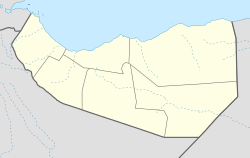Heis (town): Difference between revisions
Reverted to revision 784113636 by Habar Awal king (talk). (TW) |
Reer Libaax (talk | contribs) Expanding this page. |
||
| Line 23: | Line 23: | ||
|subdivision_name ={{flag|Somaliland}} |
|subdivision_name ={{flag|Somaliland}} |
||
|subdivision_type1 =[[Administrative divisions of Somalia|Region]] |
|subdivision_type1 =[[Administrative divisions of Somalia|Region]] |
||
|subdivision_type2 =[[Administrative divisions of Somalia|District]] |
|||
|subdivision_name1 =[[Sanaag]] |
|subdivision_name1 =[[Sanaag]] |
||
| ⚫ | |||
|subdivision_type2 = |
|||
| ⚫ | |||
|government_footnotes = |
|government_footnotes = |
||
|government_type = |
|government_type = |
||
Revision as of 13:27, 1 August 2017
Heis | |
|---|---|
Town | |
| Coordinates: 10°53′47″N 46°55′16″E / 10.89639°N 46.92111°E | |
| Country | |
| Region | Sanaag |
| District | Badhan |
| Time zone | UTC+3 (EAT) |
Heis ([Xiis] Error: {{Lang-xx}}: text has italic markup (help)) is a coastal town in the northern Sanaag province of Somaliland. It is the third largest town in El Afweyn District after the capital El Afweyn and Garadag.
History
Heis is located to the west of Salweyn and Macajilayn.[1]
The site said to be identical with the ancient trading post of Mundus (Μούνδος in Ancient Greek) that is described in the Periplus of the Erythraean Sea, an anonymous account by an Alexandrian salesman from the 1st century CE.[2][3]
A large collection of cairns of various types lie near the city.[4] Excavations here have yielded pottery and sherds of Roman glassware from a time between the 1st and 5th centuries.[2][3] Among these artefacts is high-quality millefiori glass.[4] Dated to 0-40 CE, it features red flower disks superimposed on a green background.[5] Additionally, an ancient fragment of a footed bowl was discovered in the surrounding area. The sherd is believed to have been made in Aswan (300-500 CE) or Lower Nubia (500-600 CE), suggesting early trading ties with kingdoms in the Nile Valley.[6]
Demographics
The town Heis has a total population of 3,657 residents. The town is primarily inhabited by people from the Somali ethnic group, with the Habar Jeclo sub-clan of Isaaq well-represented.
See also
Notes
- ^ Somali Studies International Association, Hussein Mohamed Adam, Charles Lee Geshekter (ed.) (1992). The Proceedings of the First International Congress of Somali Studies. Scholars Press. pp. 39–40. ISBN 0891306587. Retrieved 13 October 2014.
{{cite book}}:|first1=has generic name (help)CS1 maint: multiple names: authors list (link) - ^ a b Periplus of the Erythraean Sea
- ^ a b "Mundu" (in German). University of Bern. Archived from the original on 2007-08-15.
{{cite web}}: Unknown parameter|dead-url=ignored (|url-status=suggested) (help) - ^ a b Newsletter of the Society of Africanist Archaeologists in America, Issues 8-13. Department of Archaeology, University of Calgary. 1976. p. 5. Retrieved 25 September 2014.
- ^ Meyer, Carol (1992). Glass from Quseir Al-Qadim and the Indian Ocean Trade, Issue 53. Oriental Institute of the University of Chicago. p. 37. ISBN 0918986877. Retrieved 25 September 2014.
- ^ Hatke, George (2013). Aksum and Nubia: Warfare, Commerce, and Political Fictions in Ancient Northeast Africa. NYU Press. p. 152. ISBN 0814762832. Retrieved 16 September 2014.
References

